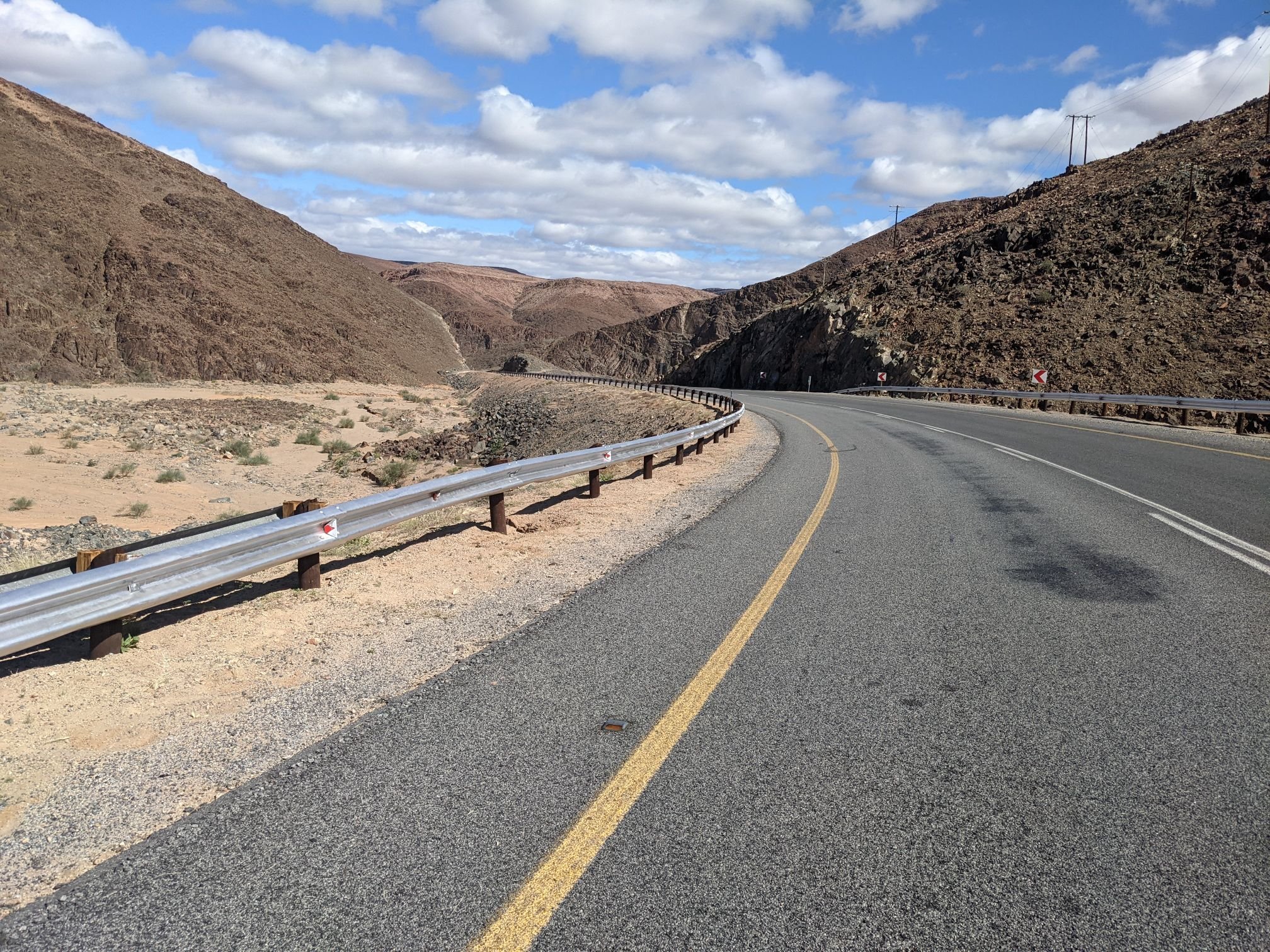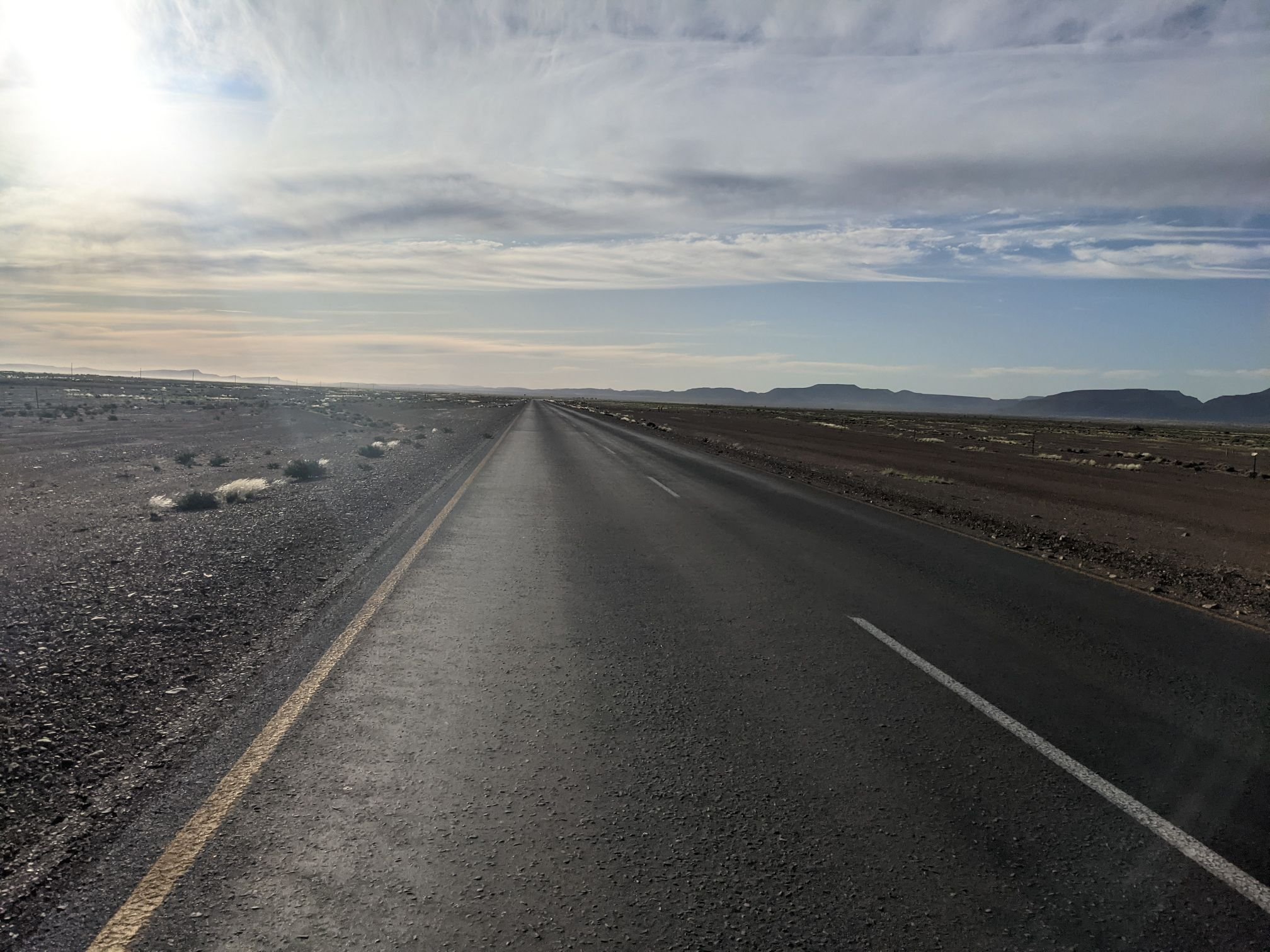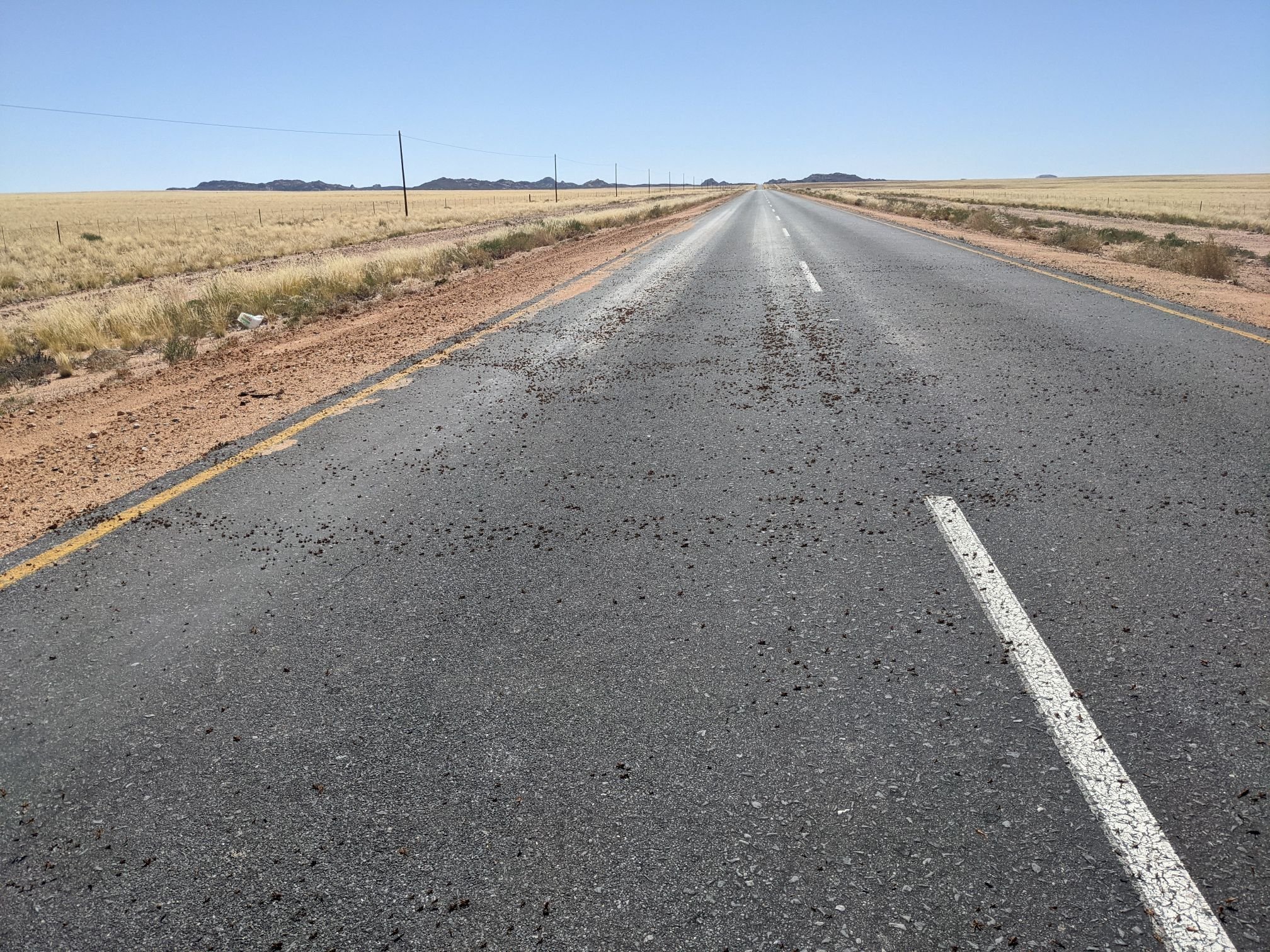From Steinkopf it was a 70 kilometre ride through the desert to the border with Namibia, country number 100.
During my rest day in Steinkopf, another cyclist had arrived. And so we set off together, myself and Roman, a Spanish cyclist who’d begun his tour in Cape Town.

It was nice to have another cyclist to chat to but as is often the case we travelled at very different speeds. After a couple hours I rode on ahead, through the desert that gradually became more and more barren.

The road descended out of the mountains down to the Orange river, which marks the border between South Africa and Namibia. It was a surprisingly big river given the arid surroundings.

I made my way to the South African border post and got stamped out. I’d first entered South Africa six weeks earlier. Even though some of that time was spent in Lesotho and Eswatini, it’s still the most time I’ve spent in any country since leaving the UK.

At the Namibian border I was given a piece of paper which I had to get stamped at several places. First was a health check, where they checked my vaccine certificate – Namibia no longer requires a PCR test, as of a couple weeks ago. I collected the stamps from immigration, the road authority and customs, then was allowed to go.
I picked up a sim card from a petrol station then continued on, riding parallel to the river, past several vineyards.

Where the river curved around, the road went straight across. Up through the hills I went, through a desert far emptier than that on the southern side of the river.

Back at the river, I passed kilometre after kilometre of vineyards. At the center was a village, Aussenkehr. Almost all the villages here were made of straw – with the exception of a concrete shopping complex, complete with a Spar. It wasn’t as well stocked as those in South Africa but it had all I need. Namibia is the first country I’ve been to since the UK, I think, where masks are not worn even in big supermarkets.

Someone came up to speak to me and asked, among other things, how I was coping in the colder temperatures as the southern winter approaches. It was about 30°C while we were having this conversation.
A few kilometres after the village the valley narrowed, and the vineyards came to an end. So did the tarmac. Where the road changed to gravel, a sign claimed the road was closed. I checked with some locals and they assured me it was passable.
In the evening the river curved again and the road climbed up into the hills once more. Here there was quite a bit of construction work going on; some vehicles came the other way, having finished for the day.
After climbing up a few hundred metres with the setting sun in my eyes, I began to descend to the river. The surface was worse here, with a lot of washboard and occasional sections of deep, loose gravel.
I made it most of the way back to the river, then stopped for the day. I pushed the bike away from the road, behind some rocks, and set up camp.

In the morning I finished off the descent, then rode along the river. For the first couple hours I had the road completely to myself.



After a couple of hours following the river, the road turned inland. The first part of the climb was steep enough that it had been paved with concrete.

About 10 kilometres after leaving the river behind, I joined a tarmac road. There was a strong tailwind and I flew along, despite the slight uphill. Another 10 kilometres brought me to Rosh Pinah, a mining town.

After a while riding around I found a pharmacy. They had a sign on the door – “we are open, the door is just closed due to the AC.” I went in, and was told they’re closed. One of the people working there kindly served me anyway. All I needed was some sunscreen; I’d misplaced mine about a week ago. Since then I’d spent the afternoons with my buff worn like a mask, to stop my nose burning. It worked, but it’s not the most comfortable thing while cycling.
I also stocked up on water, as it would be about 170km to the next settlement. There would be passing cars so I could always ask for water if I needed to, but I’d prefer not to need to. I rode out of town with around 9 litres.

The tailwind was still present. Despite the fact I climbed about 800m, I was riding at a speed I’d normally do on the flat.
When it came time for a descent, I was flying on. The gradient was very gently downhill but I coasted along at 55 kph. After a while the road turned; the wind was still mostly a tailwind but not as strongly as it had been.

In the evening I climbed down into a drain. Unusually this drain was not perpendicular to the road, instead it was fortunately angled just right to block the wind.

About an hour before sunrise the wind picked up, now coming from a different direction. Packing up the tent was made uncomfortable by sand flying into my eyes, so I wore my sunglasses despite the darkness.
This strong wind was somewhere between a headwind and a crosswind. It made for very slow going as I inched my way up the gentle climb towards Aus.



Around midday, the windspeed lessened significantly and I was able to ride at a somewhat more normal pace for the rest of the way to Aus. It was quite a small village but it had a shop, where I bought another day’s worth of food. There was a water tap marked on iOverlander near a (closed) tourist information booth, but the water didn’t seem very clean. I filled up at the police station across the road instead.
A few kilometres out of Aus I turned off the tarmac road, and onto a sand/gravel one. The distance to the next village was less than the gap before Aus, but I wasn’t sure how bad the road surface would be.

It turned out to mostly be pretty good, though I didn’t want to go too fast as there were occasional pits of deep sand that weren’t always visible. Nonetheless I rode at a decent pace as I descended into the grassy plains.

There weren’t many hidden wild camping opportunities available on the plains, and I was feeling tired from the morning’s headwind. It was therefore an easy decision to stop a bit earlier than usual when I passed a quarry. I set up camp behind some mounds of gravel.
The wind picked up in the morning and so when I set off I was going slow, crossing the wide, grassy valley. The Namibian plains are usually don’t have much grass but apparently there has been a lot more rain this year.

I continued on through a range of hills and across another valley. Like the day before, the wind lessened around noon.

When I rode through the next range of hills, there were quite a lot of trees around. There was a dry river nearby and around that area everything looked a lot more green than is usual for Namibia.
In the afternoon I reached Helmeringhausen. It’s not really a village, just a petrol station/shop/hotel. I stocked up at the shop then went backtracking – it was a little out of my way but I’d needed to buy food.

After four kilometres I turned off onto a minor road, which was even quieter than the other roads. Instead of seeing four or five vehicles an hour, I saw none for the remaining two hours of the day.

I was glad there weren’t any cars as the visibility was pretty poor as I cycled uphill facing right toward the setting sun. After a while the road turned and I cycled through a shadowed valley.

It was quite dark by the time I reached my goal for the day, a campsite. However, it looked closed. I checked with a man living in a farmhouse by the campsite and it had indeed shut down. He kindly said I could just pitch my tent anywhere I wanted though.

Apr 5: 161 km
Apr 6: 158 km
Apr 7: 103 km
Apr 8: 116 km
Hi Sam, I am a friend of Colin’s here in Calgary who has been forwarding your trip logs to me. I am mightily impressed by your courage and unbelievable stamina in cycling through Africa. Be careful as you enter the western Africa with potentially hostile groups operating in some of these areas.
LikeLike
Thanks Jorg, and sorry for taking so long to reply. Thanks very much for reading, and for the compliments!
Yes, I’ll be careful. My plan is to generally stick to coastal regions, avoiding the more dangerous countries such as CAR, Chad, Niger, Burkina Faso and Mali.
Sam
LikeLike
Hello Sam
Haven’t received a blog for a couple of weeks and was wondering if all is OK with you. I know you were going to take a break to regenerate the muscles et al.
The next section of your journey will be very interesting. I’m reading a book by Paul Theroux who covered much the same route as you plan to do in Namibia and Angola. He doesn’t go beyond Angola. The book is titled The Last Train to Zona Verde. Very good.
Stay fit, stay healthy and enjoy the next leg of your fantastic journey.
Hope to get together in Calgary in the not too distant future.
Colin Graver
LikeLike
Hi Colin
All is well here. I did take a couple weeks off in Windhoek for visas. I’ve been back on the road a while now. I’m in Angola; the internet here is very weak. I’ll upload when I get a good enough connection!
Sam
LikeLike